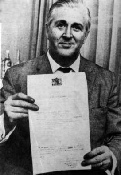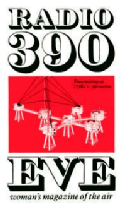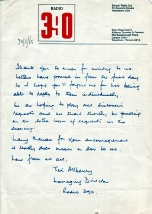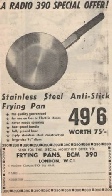© 2014-


Radio 390 - History
1965
After KING Radio had been on the air for a few months it became apparent to financial backers that in its existing state the station would never be commercially successful. One of these backers, David Lye, although concerned about the financial viability of KING Radio, was still convinced that a non-
Radio had been on the air for a few months it became apparent to financial backers that in its existing state the station would never be commercially successful. One of these backers, David Lye, although concerned about the financial viability of KING Radio, was still convinced that a non-
A report from Allbeury Coombes and Partners was subsequently presented to the owners of KING Radio suggesting the introduction of a radically different format for the ailing station, one which relied totally on what they referred to as 'sweet music' presented as an audio magazine targeted at a specific daytime audience sector -
As well as a general format the actual style of presentation was also considered by Allbeury's consultancy and it was recommended that the brash, psuedo-
In summary the report recommended that "the programmes should be sweet in flavour and soft in presentation". A further important recommendation was that the range of the station's transmissions should be increased to cover the most important market areas -
At first it was planned to rename the station Radio Eve, but Ted Allbeury quickly realised that this title reflected only the target audience and did not convey the station's wavelength to potential listeners. As the wavelength would not necessarily be published in the press or appear on radio dials, a decision was made to change the new station's name to Radio 390. The audio women's magazine concept was retained however, under the umbrella title "Eve-
On adoption of these recommendations by the owners of KING Radio, the business plan prepared by Allbeury Coombes and Partners was used to raise new financial backing and a new company, Estuary Radio Ltd., was formed to operate the revamped station.
Most of the fresh capital, was raised by three new directors and much of it was used to buy out the remaining owners of KING Radio and to purchase new technical equipment in line with the objective of substantially increasing the station's coverage area. A new transmitter was installed on Red Sands Fort during the summer of 1965 and a new 150' (45.72m) aerial mast was erected on one of the towers, which itself was over 80’ (24.38m) above sea level. Two new studios were custom-
Radio 390 made its first test transmissions on 23rd September 1965 with regular programmes of easy listening or 'sweet' music, starting a few days later on 26th September 1965.
There  were no DJs on Radio 390, presenters were known as 'announcers' and were positively discouraged by station policy from promoting themselves as personalities, then a common practice on the Top 40 format offshore stations. In keeping with its overall policy of projecting a 'respectable and traditional' image the station also adopted the practice of closing its transmissions at the end of each day by playing the National Anthem.
were no DJs on Radio 390, presenters were known as 'announcers' and were positively discouraged by station policy from promoting themselves as personalities, then a common practice on the Top 40 format offshore stations. In keeping with its overall policy of projecting a 'respectable and traditional' image the station also adopted the practice of closing its transmissions at the end of each day by playing the National Anthem. 
Unlike its predecessors on Red Sands Fort (Radio Invicta and KING Radio) Radio 390 was an immediate success with audiences and advertisers alike. The station attracted contracts from large and well known national advertisers from the outset. Ted Allbeury's imaginative concept of targeting a different audience from the other offshore stations and playing a completely different type of music proved that there was indeed a place in the market for an easy listening station.
Radio 390's success was also assisted by the strength and quality of its transmission signal. The combined aerial and Fort tower height of 230' enabled the station to use a wavelength of 388m (announced on air as 390m) which was a clear channel away from the more crowded middle and upper end of the medium waveband.

Daily close of ‘Eve -

Ted Allbeury

Click on picture to enlarge
Managing Director, Ted Allbeury, replied to listeners who contacted the station when it opened
(Click to enlarge)

Mendac Coats



Nylon stocking offer



Announcer David Sinclair introducing ‘Sunday Swing Session’, 18th June 1967


Radio 390 promoted special offers for its listeners such as this one is for a stainless steel frying pan

History
Key Dates
Fort and Location
Technical
Staff
Programmes





For more about Radio 390 visit
In the Special Exhibitions Gallery on the Ground Floor

Treasure Chest


Unknown (USA) newspaper 27th December 1965




Back to Britain Gallery


Back to Radio 390
